Before 2020, the idea of lengthy wait times for construction materials was not only unheard of, it was unacceptable. Over the last two years however, as the supply chain crisis has continued, material shortages in construction have become a reality on nearly all construction job sites. Further complicating the issue is inflation in the cost of materials, which continues to rise on a week-to-week basis.
Today, clients not only have to adapt to inevitable delivery delays and rising costs, but general contractors have learned they must come to the pre-construction process equipped with options to decrease both wait-times and budgets.
Despite these complications, businesses continue to invest in their spaces to entice employees to return to the office after years of working remotely. With demand for tenant interiors still high, general contractors must address ongoing supply chain and inflation issues from the beginning of a construction project.
Talk it out
Communication with clients and trade partners in today's climate is vitally important. Conversely, clients must also communicate with their construction team regarding their expectations about budget and schedule at the onset of a project.
General contractors and trade partners want to produce the best possible outcome for their clients but can only work with what they know. These conversations are tough but setting and managing expectations from the start will increase the likelihood of a successful project.
Finding alternatives
It is no secret that today's supply chain continues to be extremely unpredictable. Materials that might be available today could end up delayed for weeks if the order is put-off until tomorrow. As a result, contractors researching and recommending material alternatives has become a standard practice in the industry.
For example, delivery on a specified tile may have a longer wait time. The client can order an alternative tile with similar features that will come two weeks faster but will cost an extra $10 per square foot. It is the client’s decision as to whether time or money is more important to them. General contractors can help clients make informed decisions by bringing as many options to the table as possible as early as possible.
Have a back-up plan
Considering all options on a project can be a time-consuming process. Although general contractors and trade partners want to complete a project efficiently, they also want to ensure its success. Today's climate has made locating the best products and materials to fit a project's timeline and budget a much slower process. It is now common for a general contractor to be talking to five different vendors about three different products simultaneously. Where there used to only be 12 options for a particular material, there are now 50 options. Project teams will not rush this process. It is crucial in these times to be flexible to ensure a project is completed as efficiently as possible.
Flexibility regarding project start time and phasing can result in significant savings for a client. A general contractor on a project that initially was three phases, may consider if the project can be completed in two. As a result, approximately six months of staff time and expenses are eliminated, potentially saving the client hundreds of thousands of dollars.
Another solution to managing materials delays and rising costs is to push back the start of the project until essential products are available. This can help shorten the duration of the project. Of course, some clients have move-in dates and leases to consider. But if pushing back a start date is an option, it can ensure a more efficient schedule.
Consider all costs
There are times when a general contractor and their trade partners are unable to fight cost escalation. In these cases, the client should consider all alternatives:
- Think about what features in their space they really want versus the ones they need. Taking out features that aren't needed or redundant saves both time and money.
- Consider less expensive alternatives to some “wants" that could make a feature still fit into the budget.
- Think about what could be included to get employees to come back to the office. Open and collaborative workspaces with high-end amenities help clients put more life into the workplace. It puts an emphasis on company culture, which is becoming a key aspect for employees.
Over prepare and over communicate
While we continue to deal with uncertainty in the supply chain and in cost escalation, general contractors must err on the side of caution and include contingencies in the initial project budget. Proposing a higher number may seem overly conservative at first, but it is safer to expect the unexpected and have extra cushion in the budget. If a situation arises during a project, contingencies will help combat potentially tough conversations down the road.
Clients should be wary of contractors that propose budgets that seem too good to be true. The result of hasty and careless estimating can cause significant issues later in the project.
When an unexpected change in delivery and cost does occur, it is essential to let the client know as quickly as possible. These are also tricky conversations, but as soon as the issue is addressed, the sooner the team can resolve it.
Despite the current economic environment, the construction industry shows no signs of slowing. Teams need to prepare for challenges that could arise and proactively present solutions. Maintaining open lines of communication and coming armed with options are vital techniques to set up a project for success.










